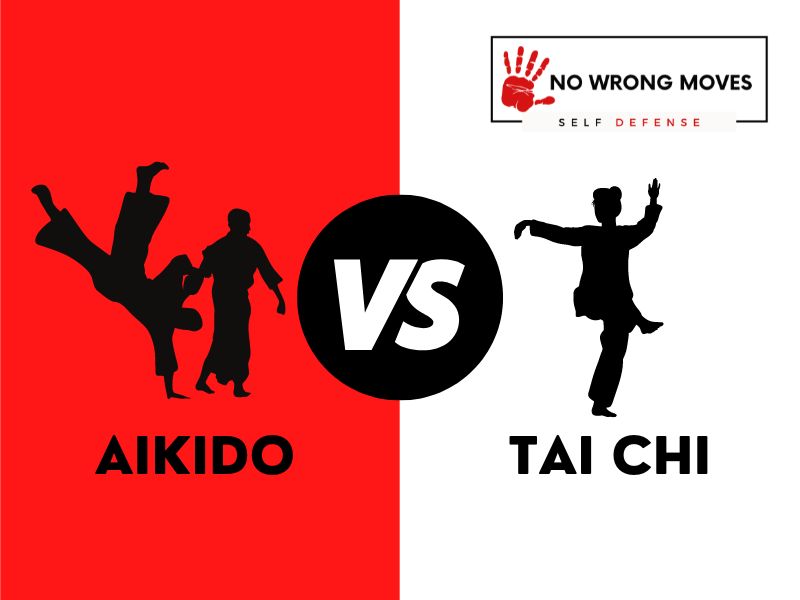
- What We Know About Aikido
- What We Know About Tai Chi
- Key Elements Of Aikido
- Key Elements Of Tai Chi
- Aikido Rankings & Levels
- Tai Chi Rankings & Levels
- Aikido Vs. Tai Chi Attire
- What A Typical Aikido Training Session Looks Like
- What A Typical Tai Chi Training Session Looks Like
- Aikido Movies
- Conclusion: Aikido Vs. Tai Chi
Many people in the martial arts community debate whether Aikido or Tai Chi is the better practice. While both offer unique benefits and principles, there are some key differences that set them apart.
The main difference between Aikido and Tai Chi lies in their intended purpose. Aikido is a self-defense-based martial art, using techniques such as joint locks and throws to neutralize an attacker.
Tai Chi, on the other hand, is more focused on cultivating internal energy and promoting physical and mental well-being.
Another distinction is the approach to combat. Aikido emphasizes using the attacker's momentum against them, while Tai Chi focuses on redirecting the force in a more relaxed manner.
In terms of physicality, Aikido involves more dynamic and physically demanding movements. Tai Chi promotes slow, controlled movements that focus on balance and coordination.
Those are the main differences between Aikido and Tai Chi, but if you want to learn more, I've broken down their ranking systems, benefits and even top movies featuring each art below!
What We Know About Aikido

The art of Aikido is overall a defensive martial technique. This means it's not intended to work aggressively, but rather when somebody becomes aggressive towards you. The aggressor in this case will often take on some form or another.
A lot goes into each movement, regardless of if it's standing still or moving around. has been considered aesthetically beautiful thanks largely due to its fluidity and grace. Learning how to properly balance yourself and redirect an attacker’s energy is key for the art of Aikido.
One important aspect of Aikido is also being able to control your own emotions during a potentially tense situation. It teaches practitioners to remain calm and in control, instead of escalating conflicts or resorting to violence as a first option.
Overall, Aikido is not just about learning self-defense techniques, but also about the discipline and mindfulness that goes into each movement and decision made during an altercation. It can be a fulfilling practice for both the body and mind.
What We Know About Tai Chi
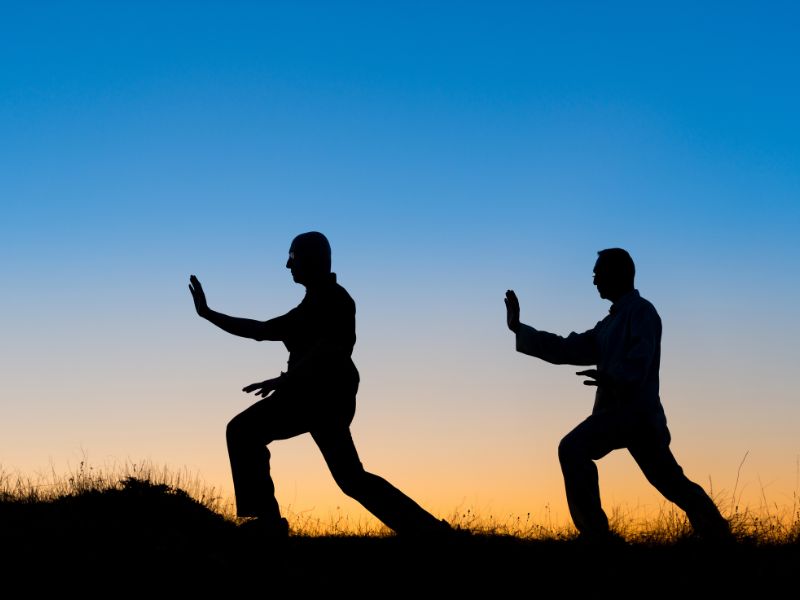
Tai Chi is a martial art that originated in China. It's based on the principles of nature and the movements of animals.
Tai Chi is practiced slowly and with purpose, and is known for its health benefits. Tai Chi is often described as “meditation in motion” because it helps to focus the mind and relax the body.
The slow, deliberate movements help to improve balance and coordination, and the deep breathing helps to increase lung capacity.
Tai Chi has been shown to reduce stress, improve heart health, and boost the immune system. It is suitable for all ages and levels of fitness, and can be done anywhere – indoors or outdoors, in a group or alone.
There is no need for special equipment or clothing, just comfortable clothes that allow you to move freely. So why not give Tai Chi a try? You may be surprised at how good it makes you feel.
Of course, this is only a brief history and understanding of Aikido and Tai Chi, but if you want to go deeper into either art, be sure to check out the following posts:
Now, back to the comparison...
Let's look at the origins of the respective disciplines and then compare the key elements of their practices. You will be able to understand some of their similarities and differences a bit better afterward.
| Aikido | Tai Chi | |
| Origins | Japanese | Ancient Chinese |
Key Elements Of Aikido
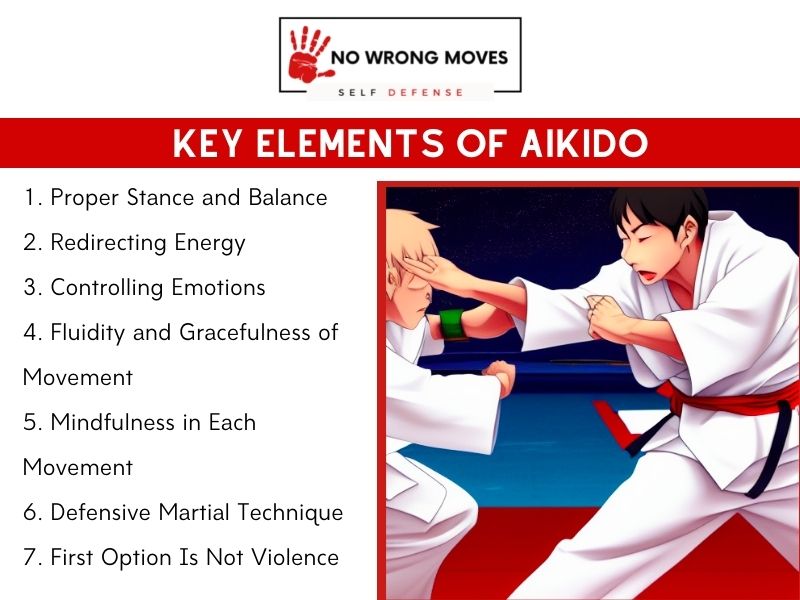
Aikido is a Japanese martial art that focuses on the proper stance and balance of the practitioner. Proper stance and balance are critical components of Aikido, as they provide the foundation for all other techniques.
A stable and balanced stance allows the practitioner to move fluidly and with control, making it easier to perform techniques effectively.
In Aikido, practitioners learn to redirect their opponent's energy rather than using force against them. Redirecting energy is one of the fundamental aspects of Aikido, and it's difficult to separate this idea from the sport itself.
Through properly redirecting an opponent's energy, Aikido practitioners can use their opponent's momentum against them, rather than relying on their own strength.
Apart from physical techniques, Aikido also emphasizes controlling one's emotions. Practitioners learn to remain calm and focused, even in stressful situations.
Aikido also places a strong emphasis on non-violent conflict resolution. The first option in any situation is to find a peaceful resolution, rather than resorting to violence.
Remember that in Aikido, the first option is not violence, and it reflects the overall philosophy of Aikido as a martial art focused on peace and harmony.
Key Elements Of Tai Chi
There are many key elements to Tai Chi, but some of the most important are the following:
The key elements that comprise Tai Chi are its slow, repetitive movements; its focus on breathing and alignment; and its incorporation of meditation and mindfulness. All of these elements work together to create a practice that is both calming and energizing.
The slow, repetitive movements help to calm the mind and release tension in the body.
The focus on breathing and alignment, as well, helps to ensure that the body is moving in a way that is safe and beneficial, while the incorporation of meditation and mindfulness helps to connect the mind and body.
Another thing I think is important to look at is the different rankings and levels in each art. if you are looking to take up either Aikido or Tai Chi, whether as a hobbyist or to compete, you need to understand the different levels of proficiency and what is required for testing and ranking.
Aikido Rankings & Levels
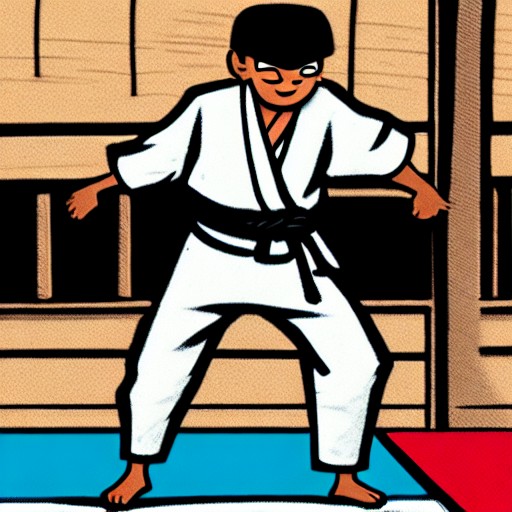
Aikido is a discipline that has many different levels, each represented by a different colored belt. The first level is white belt, which is for beginner students. Once you have mastered the basics of Aikido, you can move on to the blue belt, which is for intermediate students.
And finally, once you have mastered the art of Aikido, you can become a black belt, which is the highest level.
There are three degrees as a black belt holder: 1st dan, 2nd dan, and 3rd dan black belt. In order to achieve each of these degrees, you must pass a test that proves your mastery of Aikido.
There are also other ranks and colors that exist outside of the traditional ranking system. In some Western Aikido schools, there are more ranks added in between 1st dan and 2nd dan.
These ranks can be any combination of colors, and it allows for students to be promoted at a more gradual pace and helps to distinguish between students of different ranks.
Tai Chi Rankings & Levels
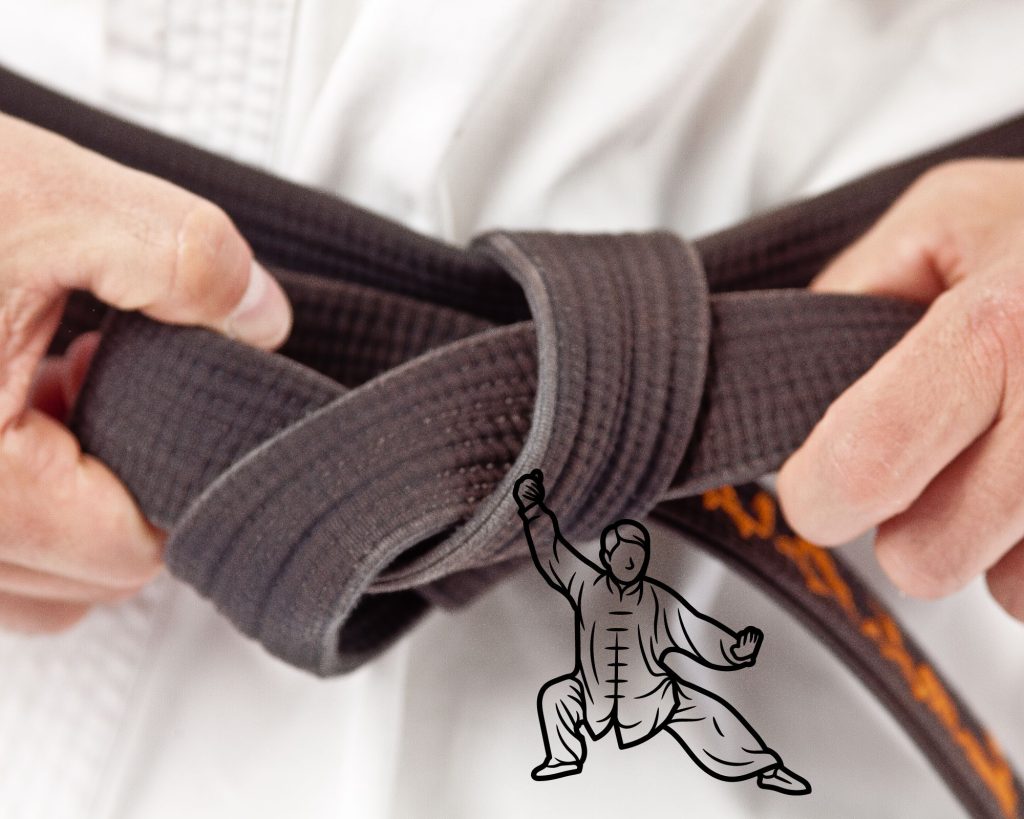
The Tai Chi rank system is a grading system used to indicate a person's progress and level of mastery in the martial art of Tai Chi. The system has three tiers: beginning, intermediate, and advanced. In each tier, there are three ranks: Copper, Silver, and Gold.
The beginning tier is for students who are new to Tai Chi. They start at the rank of Copper Eagle, Silver Eagle, or Gold Eagle, depending on their level of proficiency.
The intermediate tier is for students who have some experience with Tai Chi. They start at the rank of Copper Tiger, Silver Tiger, or Gold Tiger, depending on their level of proficiency.
The advanced tier is for students who have mastered the basics of Tai Chi and are ready to learn more complex techniques. They start at the rank of Copper Dragon, Silver Dragon, or Gold Dragon, depending on their level of proficiency.
Each rank in the Tai Chi rank system represents a different level of skill and knowledge.
As a student progresses through the ranks, they will learn more complex techniques and be able to execute them with greater precision and power. The ultimate goal is to reach the rank of Grand Master, which is the highest possible rank in the system.
Aikido Vs. Tai Chi Attire
This section simply compares the clothing and uniforms that practitioners wear in combat.
Aikido Attire:
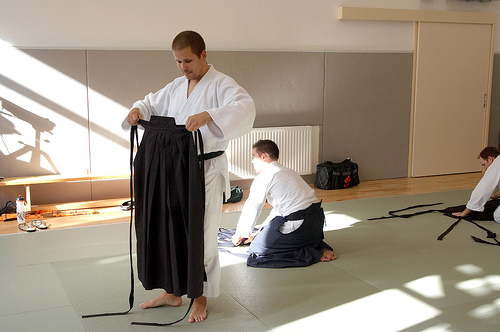
Most aikido practitioners wear a white dogi, or “uniform.” The dogi is a loose-fitting cotton kimono with a belt. In some schools, aikido students also wear hakama, which are pleated trousers that are tied at the waist and fall below the knee.
Male practitioners often don white tabi (socks), while female practitioners often wear white zori (wooden sandals). Some people also choose to practice without any clothes on in order to better feel their body and movements, but this isn't all too common.
Tai Chi Attire:

Most people who practice Tai Chi tend to wear comfortable clothing that allows for a full range of motion. Some might choose to wear loose-fitting pants and a T-shirt, while others may prefer to wear sweatpants and a hoodie. Many people also choose to practice barefoot.
What A Typical Aikido Training Session Looks Like
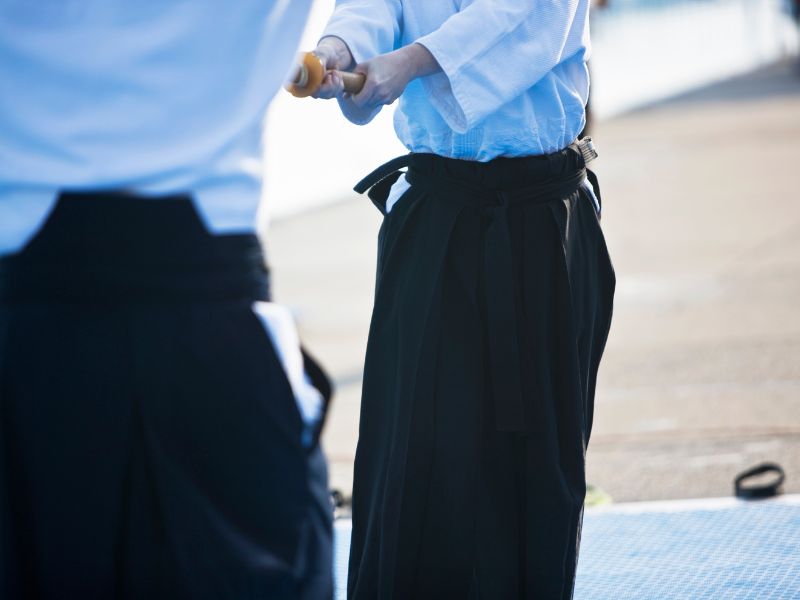
A typical Aikido practice session usually starts with a bow. This is a sign of respect for the dojo, the other students, and the instructor. The etiquette of aikido extends beyond just the bow, though. One must always be respectful, appreciative, and protective of all beings.
This attitude must be carried throughout the entire practice session.
Physical strain, whether during conditioning or in sparring against others, is part and parcel of Aikido. As such, practitioners need to maintain good manners and a positive attitude whenever they're in aikido class.
Aikido teaches you how to handle violence, but it still ultimately strives for peace, so never let your ego get in the way during your training.
Also remember that non-resistance is an essential element of proper aikido technique execution. Intercepting, deflecting, and redirecting an attack utilize the momentum and inertia of the attack.
Note that non-resistance does not mean being passively overpowered by the attack. But if you can avoid physical conflict, then you absolutely should.
It is also always important to maintain good posture and a relaxed body. Good posture includes maintaining your balance and keeping your center of gravity low. This helps you to be more aware of your surroundings and to respond more effectively to any situation.
Maintaining a relaxed body allows you to move more freely and makes it less likely that you will be thrown off balance by an attacker.
Similarly, be sure to focus on your breathing during aikido practice. This helps to calm and focus the mind, allowing for better decision making and execution of techniques.
Next, warm-up exercises are often done, including stretches and rolling or breakfalls (ukemi). These help to prepare the body for physical activity and prevent injury.
Following warm-ups, the instructor will lead the class through various aikido techniques and movements. These often involve practicing with a partner, called uke-nage (uke being the attacker, nage being the defender).
Practice with a spirit of cooperation, not necessarily competition. The goal is to mutually improve each other's technique and understanding of aikido principles, not to overpower or dominate the other person.
The practice session may also include weapons training, using a wooden sword (bokken) and wooden staff (jo). Weapons techniques often involve similar principles to those practiced with empty-handed techniques, but provide another layer of complexity and challenge.
What A Typical Tai Chi Training Session Looks Like
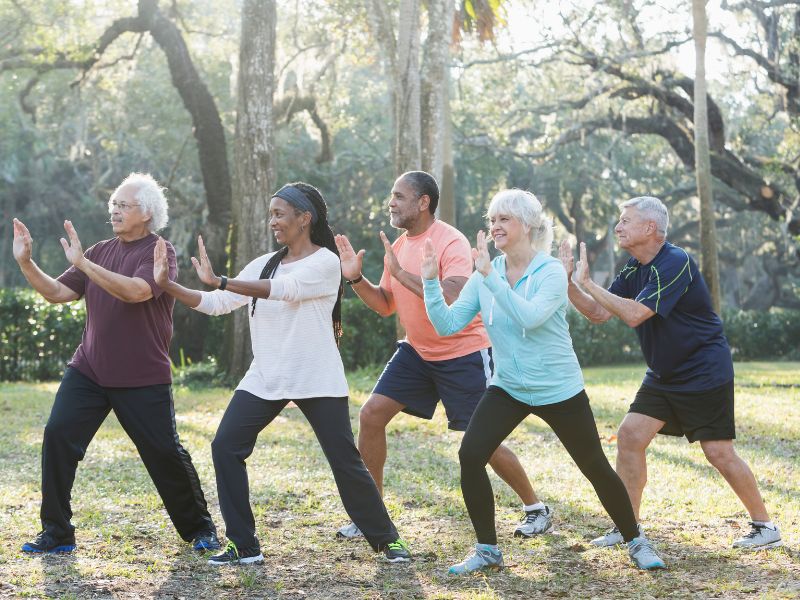
A typical Tai Chi practice session begins with a warm-up that includes gentle stretching and massage. This helps to loosen the muscles and prepare the body for the movements to come. The warm-up is followed by a series of slow, deliberate movements.
These movements are designed to promote circulation and flexibility. As the practice session progresses, the movements become more complex and flowing.
The final phase of the session is devoted to relaxation. This is often done through deep breathing and visualization exercises. Tai Chi is a meditative practice that can be performed by people of all ages and abilities.
If the last few sections have been a bit full-on or a bit too technical, you will like this next section! Why? Because who doesn't love a good martial arts flick?
Both Aikido and Tai Chi have been featured in a number of films and TV shows, so if you want to learn more about them, then entertain yourself with the following 👊
Aikido Movies

These are some of the top movies and shows with Aikido in them:
- The Blind Swordsman: Zatoichi (2003)
- The Last Samurai (2003)
- Kill Bill: Vol. 1 (2003) and Kill Bill: Vol. 2 (2004)
- Street Fighter (1994)
- Ong-Bak: The Thai Warrior (2003)
- The Challenge (1982) TV series
Aikido can also be seen in popular shows such as:
- Daredevil (2015) TV series
- Arrow (2012) TV series
- Alias (2001-2006) TV series
- Chuck (2007-2012) TV series
- Xena: Warrior Princess (1995-2001) TV series
And some amazing movies with Tai Chi in them are:
- The King and the Clown (2005)
- Remember the Titans (2000)
- Children of Men (2000)
- The Grandmaster (2013)
- Double Impact (1991)
Each of these movies showcases the beauty and power of both of these martial arts, as well as their potential for self-defense. They also demonstrate how these disciplines can be a vehicle for growth and personal empowerment.
Conclusion: Aikido Vs. Tai Chi

I hope you now have a deeper understanding of Aikido and Tai Chi. In all truth, it is not about which discipline is "better" as they each have their pros and cons. If you do plan on starting classes for either, please check out my other related posts, as I have tried my best to answer all the FAQs related to the art.
Feel free to share this post and any graphics you like, and of course, if you have any questions or thoughts, drop them below or shoot me an email, and I will be happy to assist 🙂
[author-box-jpx-fitness]
